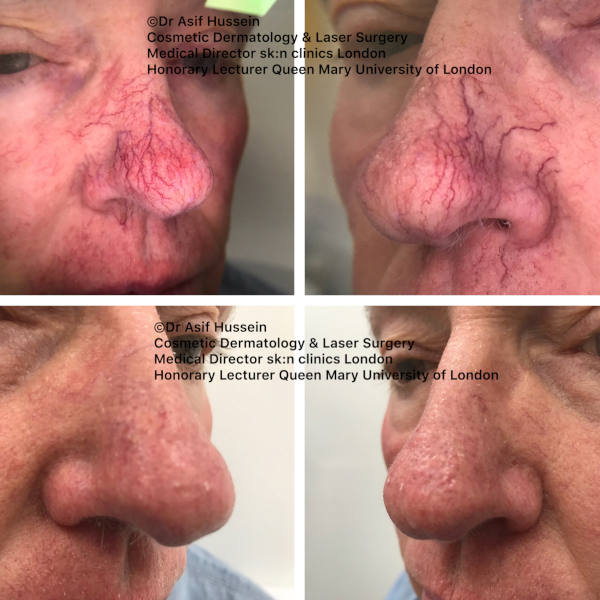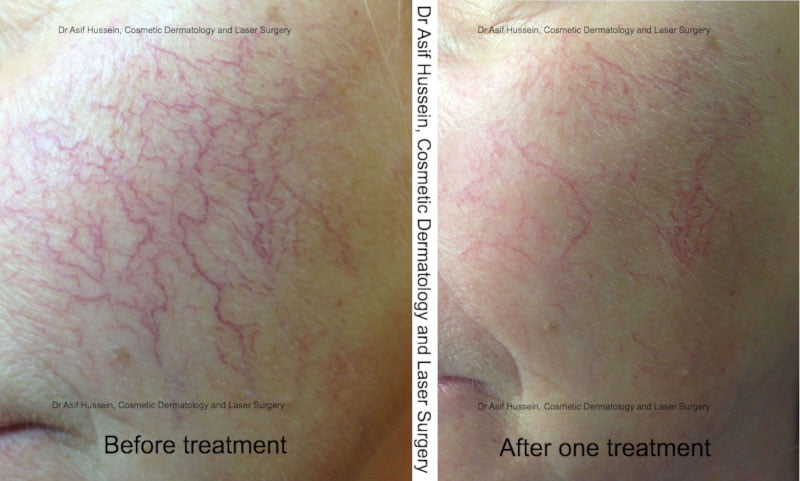INTRODUCTION
Facial veins are a common issue. They look like small spider veins and are most commonly found on the sides of the nose. They can however develop anywhere on the face. Many people will find their appearance a cosmetic nuisance that often needs to be camouflaged.
People with all skin types can be affected by facial telangiectasia but the problem is more common in people with lighter skin type as they are more susceptible to the causes of facial thread veins. The problem is also more noticeable on people with a lighter skin type. Sometimes people can find multiple facial thread veins embarrassing as red faces can trigger unfavourable associations such as excessive alcohol consumption.
Rosacea is a skin disease that affects many individuals. There are varying types of rosacea, but the underlying problem is a low-grade skin inflammation that leads to increase in the production of new blood vessels on the central facial regions (nose, cheeks, chin). As a result, rosacea sufferers can suffer with a high degree of facial redness and thread veins that can be unsightly and embarrassing. The condition can is chronic but can be treated with a variety of topical treatments and medication. Once under control laser treatment can be used to help diminish the redness and reduce symptoms of burning/heat sensation, blushing and flushing.
It is important to understand that rosacea is not a cure for Rosacea. At present Rosacea cannot be cured. It can only be controlled. Laser is a treatment for redness which is one of the symptoms of rosacea. It works by destruction and reduction of the increased number of blood vessels in the superficial skin found in Rosacea sufferers. Laser treatment in Rosacea is ongoing and requires regular maintenance due to the fact that the underlying pathology cannot be completely switched off.
Despite the ongoing need laser treatment has provided patients suffering with Rosacea a much longer lasting suppression of redness without the need for daily topicals or camouflage.
Causes of Facial Thread Veins
Factors contributing to the development of facial spider veins include:
- Sun damage
- Ageing
- Inherited disorders
- Liver disease
- Rosacea
- Injury
- Reactions to topical irritants
- Hormonal shifts associated with pregnancy and menopaus
Spider Naevi
These are small dilated blood vessels under the skin surface that look like a little central red dot with radiating little red vessels. Hence the name spider naevus or spider angioma. They can be treated in the same way as any other spider vein.
Spider Naevus

These are small dilated blood vessels under the skin surface that look like a little central red dot with radiating little red vessels. Hence the name spider naevus or spider angioma. They can be treated in the same way as any other spider vein. Please look at the photo and video sections to see what a spider naevus looks like. If you have any of these lesions Dr Hussein can get rid of them with his vascular lasers in a single session.
Treatment for these lesions is the same as treatment for facial thread veins. Please look at the facial veins part of this website to find out more about this type of treatment and costs. For most cases treatment of spider naevi is usually classed under very minor area or minor area for cost purposes.
Cherry Angiomas

These are benign blood vessel tumors that look like bright red moles. Very often when multiple in nature they can become a cosmetic nuisance. They are very easy to remove and this can be accomplished by Dr Hussein in a single treatment session.
Please see the photo below to see what a cherry angioma looks like. Please see the pictures below to understand what cherry angiomas look like. Please watch the video in the video section to see how Dr Hussein uses laser to treat these lesions. Pricing will be classed as very minor area, minor area or intermediate are depending on quantity to be treated.
TREATMENT
Laser is a gold standard in the treatment of facial thread veins. When the appropriate laser device is used treatment is quick and efficient. Simple cases can be done in a single treatment. More complex cases may take 2-3 treatments.
The most effective lasers for the treatment of facial veins are as follows:
Long pulsed NdYAG Laser (1064nm)
Suitable for larger calibre deeper facial thread veins
KTP Laser (532nm)
Suitable for finer thread veins
Pulsed Dye Laser (595nm)
Suitable for the treatment of very fine vessels which cannot be seen by the naked eye. This laser is often used in the treatment of the generalised redness (caused by a high density of micro-vessels invisible to the naked eye)
POTENTIAL COMPLICATIONS
In the hands of an experienced laser surgeon such as Dr Hussein, facial thread vein treatment carries very little risk thanks to the target specificity of lasers. This is why they are the gold standard. Treatment is quick and effective and the inconvenience of mild crusting, small bruises and a little redness is all that is encountered for 2-3 days post procedure.
If treating generalised redness such as that found in patients suffering with rosacea the more effective mode of laser treatment is that which causes bruising. Unfortunately bruising from Pulsed Dye Laser treatment for Rosacea can last for up to 7-10 days depending on severity. This can make this type of a laser treatment a little bit of a nuisance in terms of social life. However, the benefits in terms of reduction in redness and flushing symptoms are worth the downtime.
The true complications of laser are as follows:
- Bruising (Transient)
- Post Inflammatory Hyperpigmentation (Transient)
- Burn (Rare 1 in 1000)
- Scarring (Possible if a burn occurs)
- Hypopigmention (exceptionally rare)
As with any complication experience, knowledge and skill are all factors that help to achieve great outcomes with a minimum of risk. This is why choosing an expert like Dr Hussein will maximise outcomes and minimise risk.
DR HUSSEIN CASE GALLERY
Question: Why use a vascular laser instead of IPL?
Answer: Because vascular is a far more powerful and effective tool and will resolve the vein problem in less sessions than IPL.
Understanding Vascular Lasers
Used in the treatment of:
- Rosacea
- Facial Thread Veins
- Leg Veins (Telangiectasia and Reticular Veins)
- Generalised redness
- Port Wine Stain Birthmarks
- Spider Naevi
- Cherry Angiomas
- Eye (periorbital) Veins
- Venous Lakes
- Ateriovenous Malformations AVMs
- Hereditary Haemorrhagic Telangiectasia
There is a myriad of options when it comes to treating veins and blood vessels with laser. These are as follows:
- Intense Pulsed Light devices e.g. Lumenis M22 , Sciton BBL , Cutera Xeo
- Pulsed Dye Lasers (PDL/NdYAG) eg. Candela Vbeam Prima / Cynosure Cynergy
- KTP/NdYAG Lasers (Potassium Titanyl Phosphate) / LBO (Lithium Triborate)
In general, many clinics will treat with IPL devices. These are actually NOT lasers. They use a powerful light source to which specific filters are applied to simulate particular laser wavelengths. Many aesthetic clinics prefer these devices as they are cheaper and multipurpose depending on which filters are attached.
Certain treatments can be performed with reasonable efficacy with an IPL device. However, they are still a non-specialist tool when it comes to treating vascular problems like those listed above.
Experts in the treatment of skin vascular issues prefer a specific vascular laser such as a PDL/NdYAG Combined Laser (Candela V beam Prima or Cynosure Cynergy) or a Combined KTP/NdYAG laser.
The reason for this is because of the fact that they use monochromatic light and have high power output. These devices often have an NdYAG laser combined for treatment of larger blood vessels and thicker vascular lesions.
Essentially these are lasers that are specifically designed for treatment of vascular problems (Hence the ‘V’ often in the name of the device).
Pulse Dye Lasers such as the Candela V beam Prima, Candela V beam Perfecta use a special dye to produce yellow laser light of wavelength 585-595nm. This is a wavelength that is well absorbed by oxygenated blood making it a good laser for the treatment of rosacea, generalised redness, spider naevi etc.
Theoretically green laser light would be a better and more effective choice for blood vessels. However Pulsed Dye Laser was the gold standard for vascular lasers until 2010. This was because until then KTP crystal technology did not allow for green light laser beam to be produced at an adequate size and power to make it practical to treat large surface areas of skin.
The first medical vascular green light lasers only had a spot size of around 2mm in diameter. This small beam made it virtually impossible to treat larger areas. They were however useful for tracing out individual small veins and blood vessels.
Finally advances in optics allowed for green light lasers of sufficient power output and stability to be developed that would allow them to produce beams large enough to make treatment of common conditions such as rosacea much more practical. These were the next generation of devices that became the gold standard.
Combination KTP./NdYAG laser technology was pioneered in the Cutera Excel V. It still today is mainstay laser for vascular specialists and allows for superior efficacy over the PDL/NdYAG lasers that preceded it.
The latest generation of vascular laser has taken the KTP/NdYAG laser device forwards. The wavelengths are the same but the game changing device that has revolutionised vascular treatments is the Lutronic DermaV. This uses the same wavelength combination of KTP/NdYAG as the Cutera Excel V however the Lutronic DermaV can deliver laser energy in microsecond stacked pulses.
This evolution in technology allows for tougher smaller calibre blood vessels to be treated. Effectively where the previous generation of KTP/NdYAG laser would reach its maximum efficacy would result in a level of improvement that would be capped.
The microsecond stacked pulse KTP/NdYAG lasers can further reduce previously untreatable small calibre vessels giving greater improvement and clearance in conditions such as rosacea, generalised redness, port wine stains.
Sometimes manufacturers of PDL lasers will try to argue that due to longer wavelength penetration is better and it is safer on darker skin types. On the contrary the depth of penetration advantage is negligible and is easily overcome by increasing spot size in the superior KTP/NdYAG lasers.
Contrary to popular belief the KTP lasers are also safer on darker skin types as the KTP 532nm wavelength is more highly absorbed by blood vessels. This means that lower energy is required to achieve the same outcome versus a 595nm PDL. As a result, there is less of a risk of adverse consequences such as bruising and post inflammatory hyperpigmentation. Moreover, for the users of PDL the dye kit within the laser is a costly maintenance issue.
There have been many problems with the supply of Dye kits over the years leading to prolonged periods of inactivity of these lasers. The Candela V beam Prima was plagued by reliability issues and has since been withdrawn from the market. The Candela V beam perfecta is the older model that is still currently available but unfortunately has no NdYAG module.
Essentially, I would not recommend the purchase of a Pulse Dye Laser. It is rapidly becoming redundant and outdated. 532nm solid state crystal-based technology makes for a much better alternative with much less in maintenance costs due to the elimination of need for dye kits.
In summary the KTP/Nd YAG combination laser and its latest microsecond pulsed generation makes for the best-in-class device for the treatment of blood vessels.
This is why DrH still uses Cutera Excel V and has acquired the all new Lutronic Derma V.
The Lutronic Derma V is now the most powerful and versatile vascular laser on the market.








